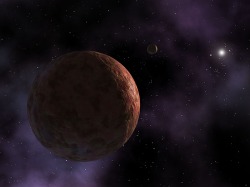Chivalloot™© By Ramsey Ronalds
100% FUN 100% FREE
100% FUN 100% FREE
TRANS-NEPTUNIAN OBJECTS
Beyond the orbit of Neptune lurk millions of icy bodies. The trans-Neptunian objects are members of the solar system like the planets and asteroids, but are too small and distant to have been detected until very recently. Pluto was the first trans-Neptunian object to be discovered in 1930. Following Pluto's discovery, scientists developed theories about populations of icy objects like the Kuiper Belt and the Oort Cloud.
Since 1992 at least 1000 thousand TNO's have been observed. Some of these have acquired names such as Chaos, Deucalion, Huya, Ixion, Makemake, Orcus, Quaoar, Rhadamanthus, Charon and the alleged planet Sedna.
Although both voyager spacecraft have traveled beyond the main region of the Kuiper Belt, neither targeted any trans-Neptunian objects. Trans-Neptunian objects have only been studied through the use of Earth-based and Earth-orbiting observatories. Finally, however, theNew Horizons mission is en route toward Pluto and its moons. After the Pluto encounter in 2015, plans call for New Horizons to travel onward to at least two Kuiper belt objects within 5 to 10 years. The Kuiper belt objects to be visited by New Horizons will be small ones, and have not yet been discovered; a search will begin a few years before the Pluto encounter.
Since 1992 at least 1000 thousand TNO's have been observed. Some of these have acquired names such as Chaos, Deucalion, Huya, Ixion, Makemake, Orcus, Quaoar, Rhadamanthus, Charon and the alleged planet Sedna.
Although both voyager spacecraft have traveled beyond the main region of the Kuiper Belt, neither targeted any trans-Neptunian objects. Trans-Neptunian objects have only been studied through the use of Earth-based and Earth-orbiting observatories. Finally, however, theNew Horizons mission is en route toward Pluto and its moons. After the Pluto encounter in 2015, plans call for New Horizons to travel onward to at least two Kuiper belt objects within 5 to 10 years. The Kuiper belt objects to be visited by New Horizons will be small ones, and have not yet been discovered; a search will begin a few years before the Pluto encounter.

